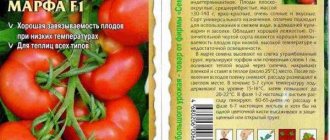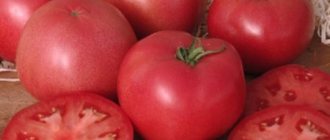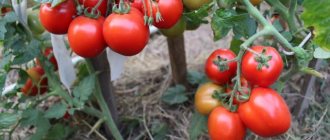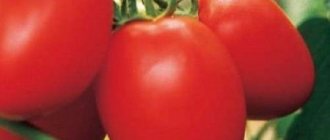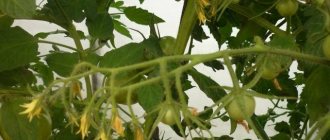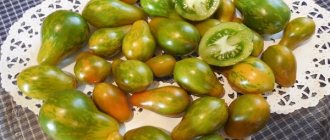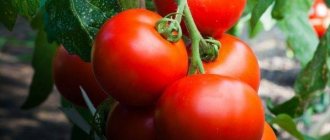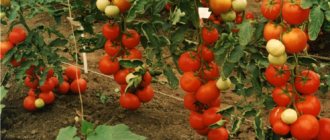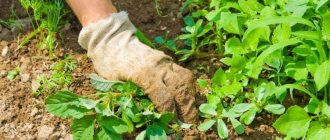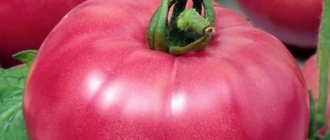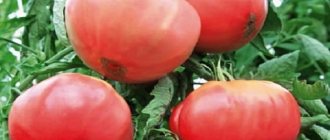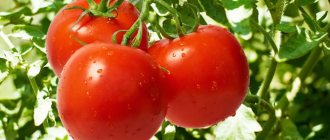Convenience in cultivating tomatoes is one of the most important indicators when choosing a variety. Agricultural technicians advise planting the low-growing hybrid Mars F1 to everyone who does not have high trellises. Low, strong supports will be enough for him to support the weighty fruitful bunches.
| Height | Landing location | Ripening time | Fruit color | Fruit size | Origin | Fruit shape |
| short | Greenhouse, Open ground | Early ripening | Reds | Average | Hybrid | Round |
Characteristics and description of the hybrid variety
The early ripening hybrid Mars matures in 3-3.5 months from the moment of emergence. It has several characteristic features:
- bush height up to 0.6 m;
- fruits are formed starting from the 6th leaf from the root;
- small leaves are painted in dark green tones;
- ripe tomatoes are bright red;
- The flat-round fruit has a good taste;
- tomatoes are not prone to cracking.
Breeders note the high yield of the hybrid.
The variety is cultivated for raw consumption, preservation, and preparation of first and second courses.
Mars F1 tomato fruits are stored for a relatively long time. The vegetable has a thick, dense skin and is suitable for transportation over long distances.
According to its characteristics, the variety is similar to cherry tomatoes. Miniature tomatoes have small leaves, medium-sized bushes, long and abundant fruiting.
Characteristics of the variety
Tomatoes of the Mars F1 variety are early ripening. The ripening period ranges from 94 to 100 days from the moment of emergence. Determinate, the bush is not very branched, the fruits begin to form above the 6th leaf. The height of the plant does not exceed 60 centimeters. The leaves are dark green in color, small, slightly corrugated.
The description of the fruit suggests that tomatoes of this variety are flat-round in shape, have a rich red color and are smooth when ripe. There are 4 – 5 seed nests. Tomatoes are small, weighing from 60 to 80 grams. The taste is excellent. Fruit composition:
- 4.5 – 5.5% dry matter;
- 3.4% sugar;
- 26 mg ascorbic acid;
- acidity is 0.5.
Those who planted this hybrid on an industrial scale noted the high yield. From one hectare you can collect from 176 to 403 quintals of high quality ripe tomatoes. In comparison with other similar varieties, this is a very good indicator.
Summer residents who grew Mars F1 tomatoes on the plot noted their good resistance not only to late blight, but also to blossom end rot. Positive qualities include the stable yield of the variety.
Timing of sowing seeds
For growing vegetables in a field, garden bed using seedlings in regions south of Rostov
region, seeds are sown in late February - early March. For the middle zone and northern regions, the deadlines are shifted by two to four weeks.
If the variety is cultivated without preliminary forcing of seedlings, seed material begins to be sown in the ground after the soil warms up to + 18 degrees.
On a note! Early tomatoes can be planted at intervals of one to two weeks. Then the harvest can take longer to harvest.
In the Rostov region and to the south of this region, it is permissible to plant tomatoes under a film booth at the end of winter. Keep the sprouts covered until warm weather arrives. When it gets hot outside, the film on the sides is opened slightly. For regions where there is frequent hail and the sun is very hot, this method of cultivation allows you to preserve the harvest.
In a greenhouse, self-pollinating hybrid varieties grow well at any time of the year. It is beneficial to sow seeds in closed ground three months before the planned ripening.
Features of cultivation and care
The Mars tomato is easy to care for and produces high yields with any growing method. Hybrid varieties are resistant to most types of pests and infectious diseases. The culture calmly tolerates changing weather conditions. Plants do not require abundant watering and frequent feeding.
Soils for nightshades are prepared in advance. They cannot be planted after potatoes. The best predecessors for tomatoes:
- peas;
- beans;
- lentils;
- mustard.
These green manures accumulate nitrogen in the ground. The remains of such plants are not removed from the garden. In autumn, the soil is plowed together with them. To prevent the beneficial substance from being washed out, you can add charcoal to the soil.
A place for planting tomatoes is chosen in open sun. Areas where there are no drafts are good. In southern gardens, corn is often planted next to the beds of these vegetables. The tall crop shades the tomatoes and prevents them from drying out in the sun.
There are plantings of garlic, parsley, and dill around. Strong-smelling herbs help protect crops from pests.
Important! Hybrid seeds are not soaked before sowing. The manufacturer applies a special layer to them.
The Mars tomato variety bears fruit best in light soil rich in organic matter and minerals. It responds positively to fertilization.
Mars F1 prefers loose soils. The beds with tomatoes are cleared of weeds. Bushes are watered in the middle zone once a week, in the southern arid regions - daily (except for rainy days).
Solanaceae do not tolerate swampy soils; their roots begin to rot. Therefore, water the plants when the soil dries out.
To make caring for tomatoes easier, you can use mulch. It prevents moisture from quickly evaporating from the soil surface and stops the growth of weeds.
In the south of Russia in the Stavropol Territory, Chechnya, Krasnodar Territory, Rostov Region, in the summer, black film mulch is treated with an aqueous solution of chalk. In these regions, from May to August, the air temperature is above 30-40 degrees. Under the black film the soil will heat up even more; the white color repels the hot rays of the sun and prevents the roots from overheating.
Tomato Mars F1: description
Mars is an early ripening type. The first tomato harvest is harvested 3 - 3.5 months from the moment of germination of the first shoots. The bushes are small, determinate (limited in growth). There are few branches on the bushes, fruits, as prescribed, are set after 6 or 7 leaves, the next fruits appear after 1-2 leaves. Bushes of the God of War variety rarely reach a height above 60 cm. The height rarely exceeds 50-60 cm. The leaves are small, rich green.
Pomona fruits of the Mars variety have a round, slightly flattened shape, and the color of the tomatoes is colorful red. One tomato weighs approximately 70-80 grams.
One child of the Mars F1 variety contains:
- Dry matter – long ago 5.5%.
- Sugar – 3.4%.
- Ascorbic acid – up to 26 mg.
- Total acidity is 0.5%.
When growing tomatoes on an industrial scale, the Mars F1 variety produces consistently high yields. All in all, farmers managed to collect more than 400 centners of high-quality tomatoes per hectare, suitable for sale. If we compare the yield of the Mars variety with other hybrid varieties, the result is very good.
Resistance to diseases and pests
Manufacturers treat hybrid seeds with compounds that protect crops from infections and insects. Mars tomatoes only get sick if they are not cared for properly. They are highly resistant to fusarium, late blight and tobacco mosaic virus. If the bushes are over-watered, the roots and fruits are affected by rot.
It is recommended to regularly inspect the plant for pests such as spider mites, aphids and slugs.
Advantages and disadvantages of a hybrid
The Mars tomato has many positive qualities:
- resistant to hot southern climates;
- cold-resistant, tolerates spring temperature changes well;
- bears fruit abundantly;
- gives away the harvest together;
- does not require care;
- rarely suffers from infectious diseases;
- not picky about the composition of the soil.
Caring for crops and mature bushes comes down to loosening, timely watering and weed removal. Fertilizing is applied according to the standard scheme.
The disadvantages of hybrids include:
- the inability to grow new bushes from collected seeds with qualities similar to those of the mother plant;
- tendency to rot with excessive watering.
Among the advantages, some users highlight the size of tomatoes. Housewives like miniature vegetables. It is convenient to place small tomatoes in jars for preservation.
Rules for growing and care
Any nightshade lover who has once dealt with hybrids, in addition to the numerous advantages of these varieties, has also noticed deprivations. Thus, it is impossible to prepare good seed material from the fruits of a hybrid plant. Of course, the seeds can be collected, planted, and even get some kind of harvest. But when seeds are planted from the fruits obtained last season, the original characteristics of the plant are lost - the variety degenerates. This weakness of hybrids is confirmed by numerous reviews from amateur experimenters. The Mars F1 variety is without exception; gardeners have to buy new seeds every year.
Despite all this, despite this disadvantage, all hybrids are very unpretentious and produce good yields, although requiring special care. In addition, hybrid varieties, as a rule, avoid pests and diseases; the plants resist the vagaries of the weather well and do not require a lot of moisture and fertilizing. But even the most picky ones need care and protection.
The bait reveals the best qualities of the tomato variety Mars on fertile, light soil. The quality responds very positively to the application of nutrients and organic fertilizers. Like all nightshades, Mars F1 loves loose soil, cleared of weeds. Bushes need to be shed approximately once a week, in dry hot weather - 5-6 times a week. The main thing is not to overdo it with water. Despite the fact that tomatoes of this variety are dense and not prone to cracking, excess moisture can lead to rotting of the root system and death of the plant.
The crisis is over; just water the bushes when the top layer of soil is completely overcooked. To prevent moisture from evaporating from the surface too quickly and to prevent the soil around the bush from drying out, it needs to be mulched. Organic mulch only retains water, but also serves as a good fertilizer for bushes.
The tomato wonderfully showed all its advantages not only when grown in large volumes, but also in the beds of summer residents and in their own plots. It is not forbidden to eat ripe fruits raw directly from the garden; they are also suitable for all types of preserves and pickles, as well as in ketchup and tomato paste.
Tomatoes withstand long-term transportation very well, without losing their marketable appearance, which is why traders love them.
Similar hybrids
There are several cultivars with characteristics similar to the description of the Mars F1 variety. Particularly close to it in terms of quality, fruit size, and yield:
- Cherry blossoms F1. The fruits ripen in 100 days. The height of the bushes is up to 1 meter. Tomatoes are flat-round in shape and colored bright scarlet. The variety has excellent taste. Miniature tomatoes weigh about 30 grams.
- Lukoshka on the window. Low bushes can be grown on the balcony. The finished product is eaten raw. The weight of a ripe fruit is about 30 grams.
- Irishka. A low-growing variety, the stem has a height of up to 50 cm. The weight of the ripened vegetable is 30-40 grams.
- Button. A plant with a central stem height of up to 50 cm. The weight of a mature fruit is 40 grams. The skin is dense and not prone to cracking.
- Children's F1. Abundantly fruiting crop. The plant is up to 60 cm high. The vegetable is not prone to cracking and is resistant to infections and pests. The fruits are tied in clusters, 8-10 pieces each. The first tomatoes ripen 85 days after the shoots appear. The low-growing early crop yields up to 7 kg per bush.
Description and characteristics of the variety
Tomato Mars F1 is a determinate, low-growing hybrid. Description of bushes:
- shoots grow up to 50-60 cm and do not require pinching;
- inflorescence simple;
- 5-7 tomatoes per bunch;
- fruitful clusters 7-8;
- stems are slightly leafy.
Ripening dates are early - 90-95 days from germination.
Fruit characteristics:
- average weight within 70-100 g;
- the pulp is dense, moderately juicy;
- dry matter level up to 5.5%;
- sugar 3.4%;
- seed chambers 4-5.
The taste harmoniously combines sourness and sweetness.
